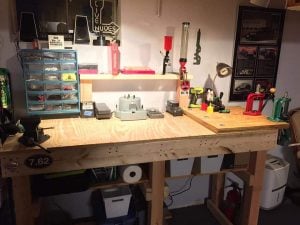 Deciding to start your path as a reloader is a choice that requires commitment, as you’ll have to invest money to buy the necessary equipment for these tasks.
Deciding to start your path as a reloader is a choice that requires commitment, as you’ll have to invest money to buy the necessary equipment for these tasks.
There are many reloading tools out there. So many, that it can be overwhelming for beginners. But we’re here to help you.
In this article, we’ll cover essential reloading tools that will be your best allies while handling and processing the ammunition.
For our picks, we’ve gone through many options, websites, and guidelines online to give you everything you need to know about the following equipment.
There’s a small consideration to keep in mind as you read our informative piece: while some of the next tools are cheap, there are others that can and will be very expensive. That doesn’t mean there aren’t cheaper versions, though, just that you’ll have to dig deeper to find those.
So it is better to confirm your demanding weights according to the manual when you load. I take huge notes on my reloading, including demanding weights. However, I never forget to check that load remains in the safe zone by following the manual.
Though it takes a little time, it prevents accidents conducted by my misguiding. It is safe and secure to follow the reloading manuals. So don’t forget to follow it.
A reloading press is one of the most important and fundamental reloading equipment that a shooter or a gun owner should have. This is where all the activity is done. Generally, there are 3 kinds of presses. These are namely:
A single stage press refers to a simple press that can do only one bullet at a time. It means it allows the die has to be replaced every time. One of the important side, this is the cheapest kind of press out there. However, it takes a little time to set up as you need to adjust your dies every time.
A turret press is different from a single press. A turret is one such progressive press that can hold multiple dies that makes the reloading convenient and faster. But removing and inserting process is still a manual function as like as a single press. One advantage is that you don’t need to readjust the dies frequently. A turret press is a bit expensive than a single press.
The final one is a progressive press which allows for the most effective, but it needs the most amount of investment. Also, it allows for a case to be seated, crimped and sized all at once. Depending on the make and model progressive press has 3 to 5 die station.
Usually, this press takes longer to set up than any other style of press. However, once you have it set up, it will produce quality, and balanced reloads for years to come.
If you are a beginner, I recommend you to use a single press. However, many people still prioritize the quality and detail of the single press over the turret and the progressive.
If you want to measure powder charges you definitely need a scale. There are two types of scale out on the market:
Both of them works fine, but the digital model is a little more comfortable and faster on the eyes. Many of us will find the digital scale perfect for measuring. I also use a digital scale over 20 years, and I have no complaint about it.
Now that we’re talking about measurement tools, calipers will also serve you well to measure different stuff. Most starter kits don’t have one, and yet, it is quite useful for beginners, amateurs, and even professionals. So, even if reloading kits don’t have calipers, you should consider them.
You can get calipers in two types, be it analog or digital dial. Regardless of which one you pick, as it depends on your preferences, each one of them will allow you to measure stuff like the cartridge length.
Calipers are good safety tools too! They will help you prevent overloading the interior of the case, which could keep you from suffering a nasty accident later on.
Basically dies are what does the job step by step. They are responsible for the resizing of the primer removal, brass, and other significant levels.
If you have pistols, I strongly inspire you to have carbide die that avoids the need to lubricate the cases. For a rifle owner, there are plenty of options including bushing dies to micrometer adjustable dies. But they are little pricey.
When using turned necks, you will find the bushing dies most helpful with some advanced technique. On the other hand micrometer, adjustable dies are pure luxury.
A shell holder is also essential equipment that you need for reloading. You need it because of your caliber that fits the press and ability for loading.
If you want to pour the powder into the cases safely, you need an easy powder funnel. You need one if you cannot throw the charges directly into the cases. They are inexpensive funnels.
Every time you fire a cartridge case, they will leave remnants behind. The amount of residue left may vary depending on how much you shoot, but the result is pretty much the same: you want to collect every bit of that as possible to reuse it later on for other purposes.
While there are plenty of options to clean all that mess, like Tide or hot water, the result is not going to be the most pleasant. That’s when the case tumbler comes in; it is a power tool that vibrates from top to bottom, cleaning the cases from every angle.
Next is primer which comes with a pistol. Before reloading, check the reloading manual to know which primer your caliber needs. Primers have a small amount of inflammable compound and a little anvil.
Rifle primers are made a hefty to deal with the higher pressures made in rifles. But do not substitute primers, because a rifle primer is not applicable for pistol cartridge or a pistol primer is not applicable for a rifle cartridge.
There are plenty of options for bullets out on the market. Some groups of bullets are known as:
Let’s have a few words about them:
The match grade bullets seem to be the most expensive bullet type. They offer better accuracy compared to the non-match grade bullets.
On the other hand, non-match grade bullets are suitable for plinking. They are also less expensive compared to the match grade bullets.
Lead bullets are known as the most logical option out there. But they come with some downsides. Most often firearm cleaning and possible risk of leading.
Reloading might not be a risky job compared to a shooting. But still, it is wise to be safe than sorry. Moreover, when working reloading gunpowder use:
The equipment needed for reloading ammunition depends on many things, some of them being the type of cartridge and your experience in the field. That’s why we wanted to talk about standard tools that will certainly improve your performance as a reloader regardless of those elements.
Keep in mind that, while the tools discussed here are necessary for reloading, there are many more that we didn’t cover. There’s no need to worry anyway, as you’ll be learning about them as you follow your path as a reloader.
Using the tools we discussed above, whether you do it independently or together, will increase your success of reloading a cartridge in the most efficient method. That is, you will be able to do it without security breaches that may return to haunt you later on.
As you can see, the tools are efficient and safe to use. In the future, you may be able to ditch some of the tools discussed here, or even better, exchange them for professional-grade reloading equipment.

Joseph Fox writes on a variety of topics ranging from reloading ammunition to gun cleaning. He has been featured on various publications like thetruthaboutguns, Sofrep & many more. Joseph is also the founder of Gunloading, where he reviews different types of reloading & firearm products available on the market.
Gunloading.com is a participant in the Amazon Associates Program, an affiliate advertising program designed to provide a means for us to earn fees by linking to Amazon.com and affiliated sites.
About Us | Contact Us | Privacy Policy | Amazon Affiliate Disclosure
Copyright © 2022 Gunloading.com All Rights Reserved